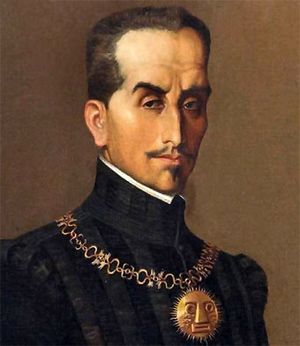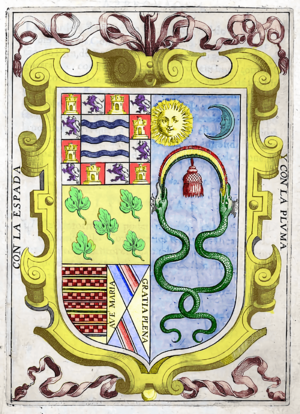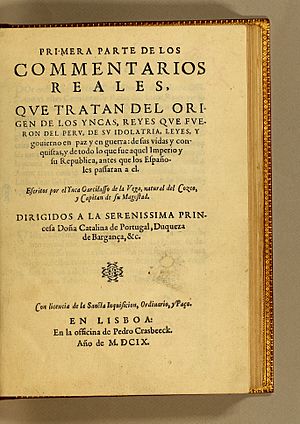Inca Garcilaso de la Vega facts for kids
Quick facts for kids
Inca Garcilaso de la Vega
|
|
|---|---|

Colonial portrait of Inca Garcilaso de la Vega
|
|
| Born | 12 April 1539 |
| Died | 23 April 1616 (aged 77) |
| Occupation | Writer, historian |
| Parent(s) | Sebastián Garcilaso de la Vega (father) Isabel Chimpu Ocllo (mother) |
| Signature | |
 |
|
Inca Garcilaso de la Vega (born Gómez Suárez de Figueroa; April 12, 1539 – April 23, 1616) was an important writer and historian. He was born in what is now Peru. He is often called El Inca because of his Inca heritage.
Inca Garcilaso de la Vega was the son of a Spanish soldier and an Inca noblewoman. He is famous for writing about the history and culture of the Inca Empire. His books were very popular in Europe. They were some of the first important writings by someone born in the Americas. When he was 21, he moved to Spain. He lived and worked there for the rest of his life.
After his father passed away in 1559, Garcilaso moved to Spain in 1561. He wanted to be officially recognized as his father's son. His uncle helped him, and he lived in Spain from then on. There, he wrote his famous histories about the Inca culture and the Spanish conquest. He also wrote about an expedition to Florida.
Contents
Early Life of Inca Garcilaso
Inca Garcilaso de la Vega was born in Cusco, Peru, in 1539. His birth name was Gómez Suárez de Figueroa. His father was a Spanish captain named Sebastián Garcilaso de la Vega y Vargas. His mother was an Inca noblewoman named Palla Chimpu Ocllo. She was later baptized as Isabel Suárez Chimpu Ocllo. She was related to the powerful Inca ruler Tupac Yupanqui.
Because his parents were not married in the Catholic Church, he was given his mother's family name. In the Spanish system of the time, people with mixed Spanish and Indigenous heritage were called mestizo.
When Gómez was young, his father married a Spanish woman. So, Gómez lived with his mother and her family. His first language was Quechua, the language of the Inca people. He also learned Spanish when he was a boy. He lived with his mother's family for about ten years. Then, his father took him into his home and made sure he got an education. When his father died in 1559, Garcilaso received an inheritance. The next year, at age 21, he left Peru for Spain.
Journey to Spain
Gómez Suárez de Figueroa arrived in Spain in 1561. At that time, there was still fighting in Peru as the Spanish conquest continued. He went to Montilla and met his father's brother, Alonso de Vargas. His uncle helped him settle in. Soon, Garcilaso traveled to Madrid. He wanted the Spanish Crown to officially recognize him as his father's son. He was allowed to use the name Garcilaso de la Vega. He was also known as "El Inca." In Spain, he received a good education, even though it was not in a formal school. With his uncle's help and his father's name, he was able to fit into Spanish society.
Later Years
Inca Garcilaso stayed in Spain and never went back to Peru. Because he had royal Inca family ties, it could have been dangerous for him in Peru while the conquest was still happening. He passed away in Córdoba, Spain, on April 23, 1616.
Family Life
Inca Garcilaso had at least two sons. His first son was born around 1570, but he might have died young. With another woman, Garcilaso had a second son named Diego de Vargas, born in 1590. Diego helped his father copy his famous book, Royal Commentaries. Diego lived until at least 1651.
Military Service
De la Vega joined the Spanish army in 1570. He fought in some battles and was given the rank of captain for his service.
His Writings
Inca Garcilaso received a good education in Spain. His books are considered very important, not just as history but also as great literature. He wrote from a special point of view. His mother's family were the ruling Inca. He described the Inca rulers as kind leaders who made sure everyone in their country was happy and well-fed before the Spanish arrived. He learned a lot about daily Inca life from his relatives. This helped him share those details in his writings. As an adult, he also understood the Inca political system. He could describe how they organized their empire and collected taxes from other tribes.
Garcilaso was raised as a Roman Catholic. His writings about the Incan religion and the Inca Empire were influenced by his Catholic upbringing.
La Florida del Inca
Garcilaso's first book was La Florida del Inca. It tells the story of Hernando de Soto's journey through Florida. The book was published in Lisbon in 1605 and became very popular. It describes the expedition using records and information Garcilaso collected. He wrote about the Spanish right to claim new lands. But he also showed the dignity and bravery of the Native Americans. This book was translated into English in 1951.
Some historians say that La Florida is more like a story than a perfect historical record. They note that some events and places might not be exactly right. It seems Garcilaso gathered stories that had been passed down by word of mouth.
Comentarios Reales de los Incas
While in Spain, Garcilaso wrote his most famous book, Comentarios Reales de los Incas. It was published in Lisbon in 1609. This book was mostly based on stories and oral histories. His Inca relatives told him these stories when he was a child in Cusco. He also used parts of a history written by Blas Valera.
Comentarios Reales has two parts. The first part is mainly about Inca life. The second part, about the Spanish conquest of Peru, was published in 1617. The book was first translated into English in London in 1685.
Later, in 1758, a rebellion against Spanish rule began in Peru. The Spanish king, Charles III of Spain, then banned Comentarios Reales from being published in Lima. He thought its content was "dangerous" because it might encourage more rebellions.
The book was not printed again in the Americas until 1918. However, copies were still passed around secretly. It was translated and printed in English in the United States in 1961 as The Incas. Another English edition came out in 1965 as Royal Commentaries of the Incas.
Honors and Legacy
- The main stadium in Cusco, Estadio Garcilaso de la Vega, is named after him.
- In 1965, the Universidad Inca Garcilaso de la Vega in Lima, Peru, was named in his honor.
- In Rome, Italy, near Villa Borghese, there is a statue dedicated to Inca Garcilaso de la Vega. It was put up in 1967.
- A similar statue, from 1973, stands in the Plaza República del Perú in Buenos Aires, Argentina.
See also
 In Spanish: Inca Garcilaso de la Vega para niños
In Spanish: Inca Garcilaso de la Vega para niños






